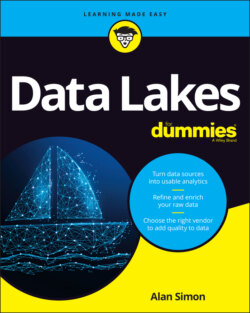Читать книгу Data Lakes For Dummies - Alan R. Simon - Страница 37
Managing Equal Opportunity Data
ОглавлениеYour data lake’s big data foundation presents you with an opportunity that, not too long ago, was out of reach for most organizations. You can store, manage, and analyze all three types of data — structured, unstructured, and semi-structured — within a single environment, and without having to jump through hoops to do so!
Many of the business questions you ask of your data will only require structured data. Suppose you work in the supply chain organization within your company. You’ll definitely want your data lake to provide insight into the following:
Who among your strategic suppliers has the best combination of on-time component production and also very low problem rates?
Which third-party logistics firms have the best — or worst — on-time shipping performance?
What’s the percentage of product spoilage among all internal and third-party warehouses during the past six months?
Other critical business analytics may involve unstructured or semi-structured data. You’ll want to know the following:
What percentage of tweets from your customers represent a positive sentiment about your product quality? Negative sentiment? What “hot spots” are showing up in blogs, tweets, and other social media posts, as well as YouTube videos, that can mean profitability and market share problems for you down the road?
Your reports show a dramatic increase in breakage in Warehouse #2. You have surveillance cameras in all your facilities. Is there anything that shows up on video that could indicate one or more root causes for this breakage that you can address through procedural changes?
Your data lake gives you one-stop shopping for structured, unstructured, and semi-structured data in a logically centralized, cohesive environment.
